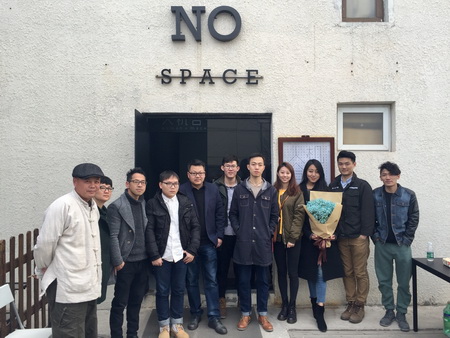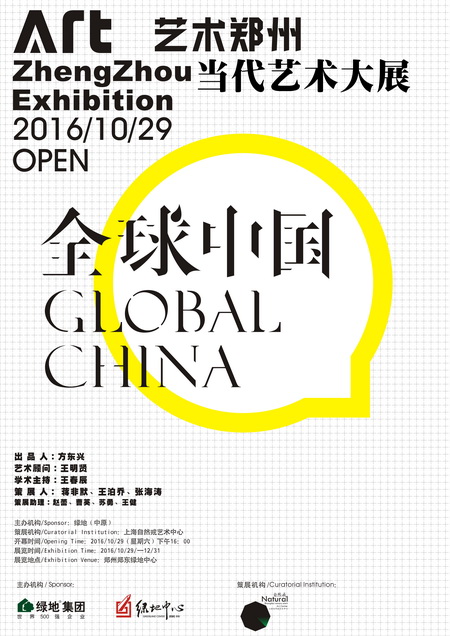
【AZZ艺术郑州】
2016“全球中国Global China”当代艺术展
出 品 人:方东兴
艺术顾问:王明贤
学术主持:王春辰
策 展 人:蒋非默、王泊乔、张海涛
策展助理:赵蕾、曹英、王健、苏勇
主办单位:绿地·中原
承办单位:上海自然戒艺术中心
开幕时间:2016年10月29日(星期六)16:00
展览时间:2016年10月29日一12月31日
展览地点:郑东绿地中心
E-mail: chinaart2016@126.com
艺术家(按姓氏字母排序):
Ash Moniz(加拿大)、艾恩·克⾥斯蒂安·⽶勒Arnd Christian Müller(德国)、边霄萌、卜桦、Garcia Frankowski(波多黎各/法国)、苍鑫、常徐功、陈庆庆、陈文令、陈友桐、戴翔、邓碧文、费俊+李心路、高文谦、郭工、汉森Johannes Nielsen(瑞典)、韩行、何盛源、胡介鸣、花俊、姬子、计文于+朱卫兵、贾鹏森、江衡、金江波、李洪波、李琳琳、李山Alessandro Rolandi(意大利)、李暐、李占洋、李子勋、梁绍基、梁越、林欣、刘健、刘茜懿、刘旭光、刘峥、卢杉、路赛·贝通Russell Beighton(英国)、马腾飞Martin Derbyshire(英国)、马晟哲、缪晓春、祁志龙、秦树义、邱黯雄、邱宇、邵译农、史金淞、孙逊、谭海山、田晓磊、童昆鸟、王雷、王薇、王维思、吴超+夏维伦、吴高钟、吴梦诗、武艺、徐一晖、许仲敏(英国)、杨泳梁、伊瑞STRAKA JIRI(捷克)、张浩、张丽丹、张沐辰、张琪凯、张巍、张湘溪、张小涛+余月雄、张彦峰、张正民、郑达、钟甦、周罡、朱冥
参展艺术家部分作品
(排序无先后)
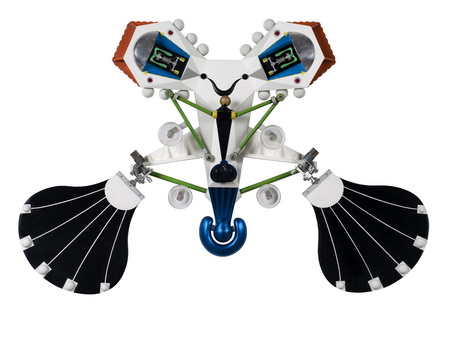
▲ 李子勋《水星人飞行器》综合媒材:压克力颜料、木材、塑胶、金属、灯、马达、机械装置、电子控制器、液晶屏幕;112x150x38cm;2007

▲ 苍鑫《巫术中的人工智能》系列方;机械装置;220x230cm;材料:树脂,铅皮,集成板,发动机,铝合金;2016
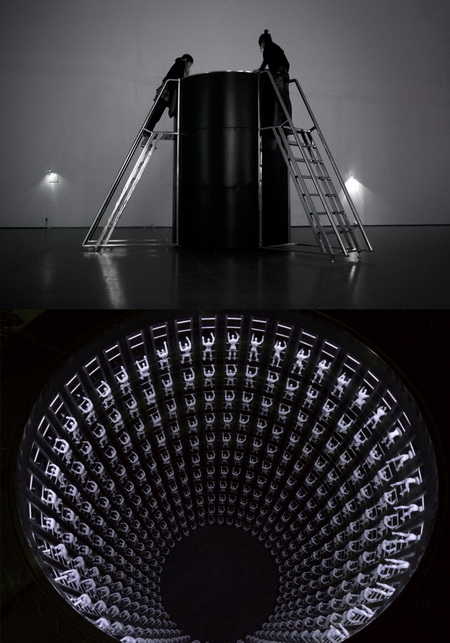
▲ 许仲敏《梯》机械装置;材料:不锈钢、玻璃钢、机械传动;260cm(h)x400cm
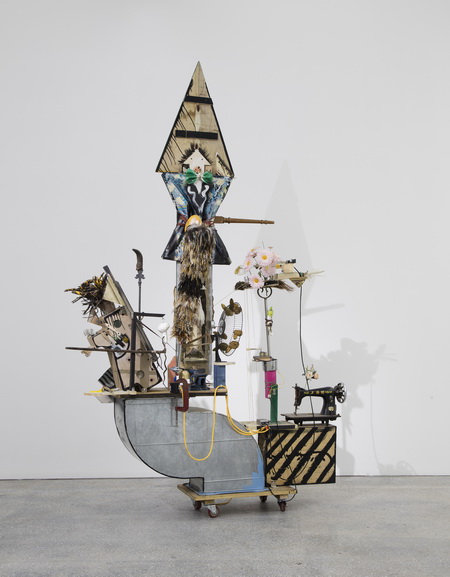
▲ 童昆鸟《瞌睡龙》动态装置;195x55x288cm;2016
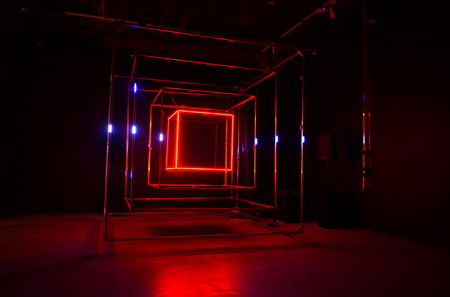
▲ 郑达《机器的自在之语》互动LED装置;2016
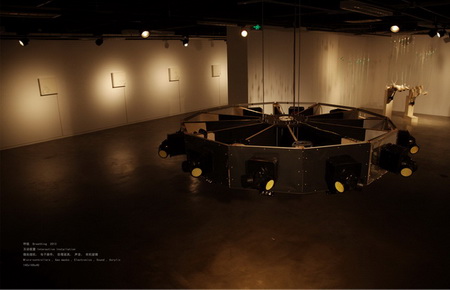
▲ 张沐辰《呼吸》互动装置;微处理机 电子器件、防毒面具、声音、有机玻璃;尺寸可变;2013
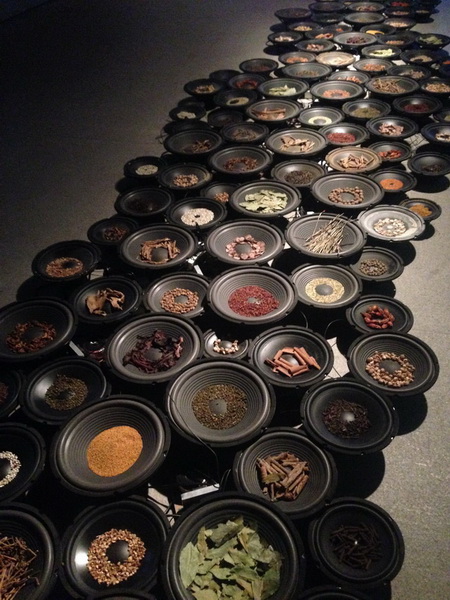
▲ 邱宇《声之味》材料:喇叭,香料;动态装置;600×150cm;尺寸可变;2015

▲ 张丽丹《活体》动态装置;2016

▲ 吴高钟《黑夜陌名者-手电筒》280×120×120cm;雕塑装置,木雕,毛发等;2005
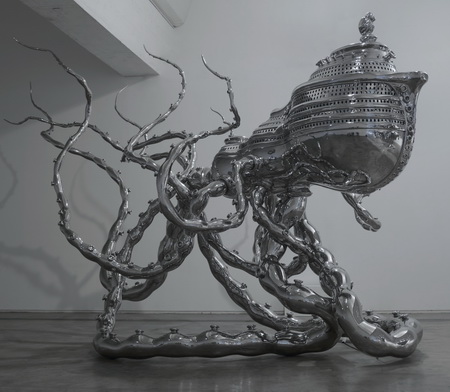
▲ 陈文令《超验的方舟Ark of Transcendenc》512x400x420 cm;不锈钢;2012
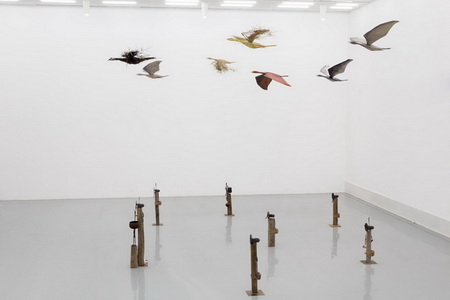
▲ 汉森Johannes Nielsen《Whispers From the Sky》动态装置;木、竹;220×120cm×5;2015
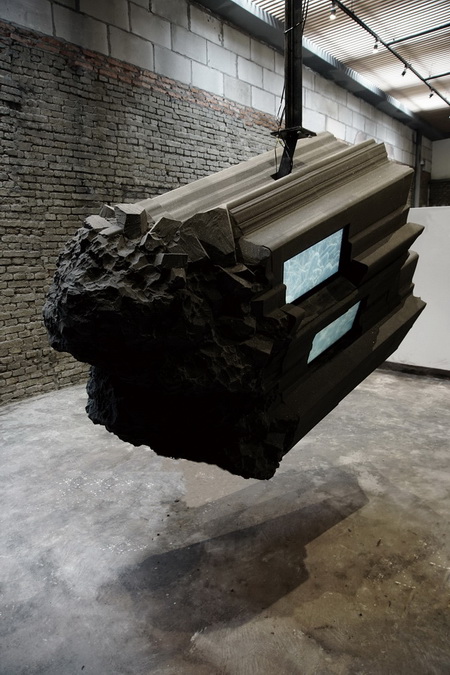
▲ 林欣《错误的秩序-废弃》电子影像装置;200×160×125cm;2014

▲ 吴梦诗《虫》动态装置;涤纶、PVC;220cm×直径30cm;2013

▲ 史金淞《经变图》影像装置;367×144cm×3;2016
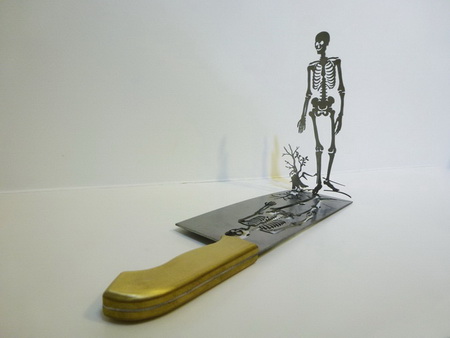
▲ 李洪波《荒芜》金属;35×9.8×1.7 cm;2014
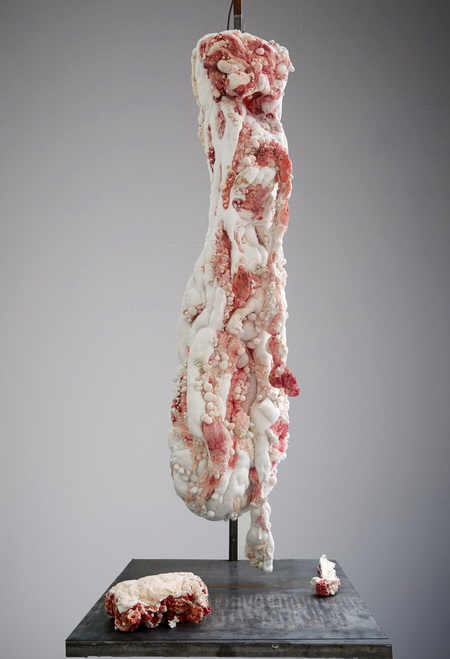
▲ 边霄萌《赛金花的大腿》材料:卸妆棉、化妆品、卸妆液;400×100×60cm;2016
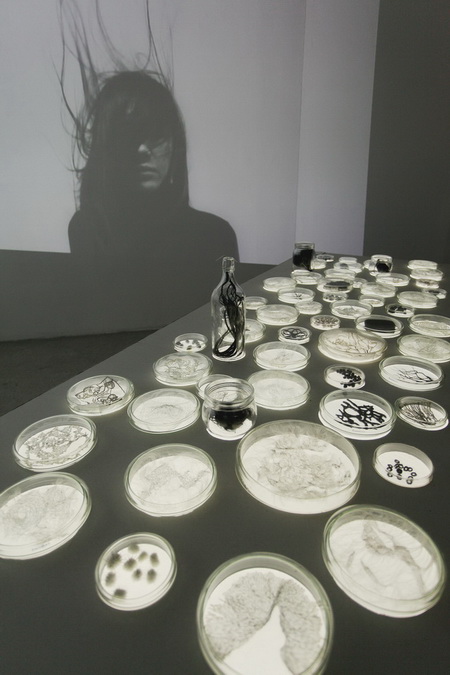
▲ 王薇《发-日记》头发、影像;尺寸可变;2015
以“全球中国”观中国
——当代艺术展在郑州
文︱王春辰(中央美术学院美术馆学术部主任,教授)
今天,说到中国,与其是关于中国,还不说是关于世界,进而是关于全球。历史有中国,乃是长时间多民族、多文化融合与互证而形成的。故此,我们今天置身于世界潮流的全球化时代,也必将迎接新的挑战和新的格局,也促使我们形成并持有“全球中国”的新视野。
“全球中国”是以21世纪为展望平台,并以历史之维来思索我们前行的路向。本次展览在郑州举行,也极具意味。因为郑州地处中原,历史悠久,幅员辽阔,这里曾经是汉唐盛世的核心地区,在历史上创造过辉煌的文明。东汉佛教东来,就最早落地在这个区域里,显示了那个时候,这里是通观天下的中心。“中国”之谓,曾经是指“国中之国”,指的就是郑州这一带的中原大地。宋代的绘画也是中国绘画的高峰之一,迄今让人仰慕,因为其姿态宏阔,气势撼人。那时,中原大地是广纳世界,汇通各种语言,交流各种思想(从佛教到景教无不来中原传播)。汉唐及宋,其人物性格与气质雄壮豪迈、吞吐八荒;而一以贯之传承有序的乐府诗词,历千年,滋养天地,百惠心灵。当我们今天回望前贤,不禁俯仰沉思,叹之有三。因为那时的“中国之中”仿佛是今天的“全球”概念,具有广域的视野,兼及天下、通览海宇,胸襟广大,纵横万里,因而“中国”并不限于中原一地,反而有“天下”胸怀。古书《山海经》读起来像是一部神话,但实际上是古人通达天下之志的指南,是纵览天下珍物的宝典。
所以,今天在新的语境和时代里,提出“全球中国”是接续历史气魄的一种志向,志在四海,可吸收世界不同的文明素养,可接纳世界上不同的文化成果。这样的“全球中国”就不限于“中国”一域的文化概念,它所要追求和发扬的是世界上优秀的文明与文化,它的文化活力和创造力是源自于世界概念,即全球化下的文化共性和价值。我们赋予“全球中国”新的内涵,就是增加“中国”概念的世界性因素,而非地域性限制。全球中国是新的文化创造,如文艺复兴在意大利兴起和繁荣,不是意大利一地的概念,它是吸收、贯通了整个欧亚古文明的质素,再注入新的知识才取得的。“全球中国”对于艺术,则是让我们更加具有了世界眼光和能力,这恰恰是在今天发展我们的当代艺术最需要的。
如果我们来观察中国近三十年来的艺术发展,可以清晰地看到这样一条路径。如果不是我们的艺术家打开心扉、开阔视野,他们断不会采用诸多的艺术表现新方法,也不会深入到全球化共性的感知中去呈现这个世界。他们即便借用固有的经典语言来表现,也是做出了百倍的努力来转换其时代表现力,增加其当代的新感知。我们纵览本次展览的艺术作品,就会深深地发现中国当代艺术的格局可以用“全球中国”来观察。以往我们对中国的艺术的界定总停留在几个方面上,如媒介必为水墨、陶瓷,题材必为花鸟草虫、山石树木;近世一变,又似乎谈中国的艺术必定是写实的、具象的、故事的、人物的等等。这些林林总总的说法时不时地会限制人们的认识,仿佛中国的艺术不应该有其他的东西出现;如果出现了,那么它们就是舶来品,就不具有合理性,就不是中国艺术。这样的判断和认识并不是少数,所以,为了更开阔地发展中国的新文化新艺术,提出“全球中国”即是要打开我们的思路,使得中国艺术家在从事艺术创作时不再被限制性的潜意识概念所制约,而要果敢地从事一切可能为我所用的艺术及其表现。
有了这样的抱负和胸襟,再来看本次展览的作品,无论我们是作为观众,还是作为研究者,就充分地获得了观看的自由和喜悦。自由,是因为面对这样丰富、多样的艺术,不仅类型多、媒介多,而且含义丰富、情景多变,大大地延伸了面对艺术一词所可能产生的触动和感动。可以说,这些活跃在当下中国艺术领域中的艺术家们,是无愧于他们追求艺术创造的梦想的——其艺术想象是与他们获得艺术的自由同时存在的,他们可能遇到的艺术挑战也在于他们果断地去尝试各种可能性媒介和方法。这不是艺术是什么呢?“全球中国”作为概念,即是肯定他们追求国际化语言与方式的合法性和可能性。同时,这样的展览也是我们回望中国艺术在当代的路标痕迹,它们历历在目地呈现了“全球中国”的艺术概念是如何构成的,它不定于一尊,也不群氓于一种,而是多样再多样。多样的意义绝不是多一点与少一点那么简单,它反映着、影响着我们和世界的关系距离以及情感。“一”是唯一不二的偏颇,它在艺术上可能导致的是狭隘和固执,极端之下,导致艺术能力下降,因为营养单一,对创造思维的吸收不利;“一”容易简化世界的丰富性和多变性,这正是当代艺术的大忌。而倡导多样性的当代艺术,正是全球中国的注解,它会考验人的智力,会发掘人的潜力,深化人的想象力。
全球恰恰是丰富的代名词,而中国恰恰是历史持久性的存在,当全球与中国联动在一起的时候,“全球中国”的语义就发生了。不仅全球中国是中国的中国,也是世界的中国,是和平的中国,是孜孜追求进步的中国,是与世界共同分享知识与价值观的中国。此刻的中国,也是近百年来的中国追求和作为。艺术,作为世界的一种公共语言,正是以其特有的魅力方式,让全球人类分享了文明、分享了情感、分享了智慧。无论是怎样的当代艺术,它都让我们这些观看者置身其中,获得的启悟是:我们不再孤单,我们前行的路上,有足够的创造在那里等待我们,让我们身心不再疲倦。
此之谓,即全球中国的艺术在那里。
2016年9月28日 凌晨 于北京花家地北里

▲ 王维思《我胡汉三又回来啦!》之三;装置;废旧电子产品、编织袋等;尺寸可变;2016

▲ 王雷《今砖今砖》2013全年《东方今报》纸裁切及打浆制砖;尺寸可变;2014
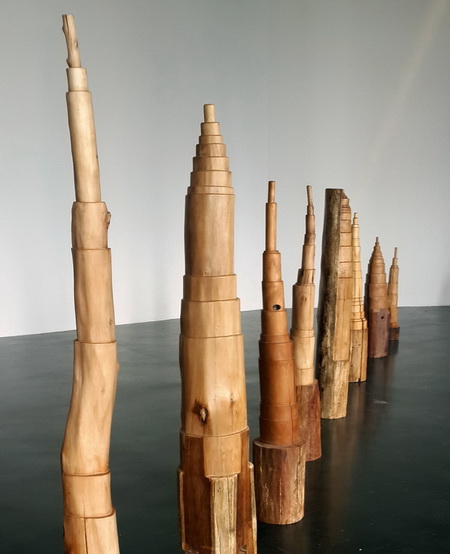
▲ 邵译农《如如之心》 松木、榆木;尺寸不等;2013
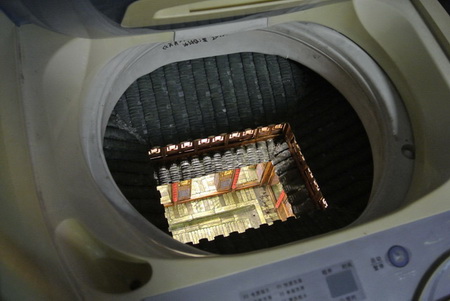
▲ 张湘溪《天井》洗衣机装置;综合材料;55×55×88cm;2012

▲ 韩行《和谐社会》瓷盘烟熏技术、蜡烛;尺寸可变;2016

▲ 郭工《钢筋肖像》木;尺寸可变
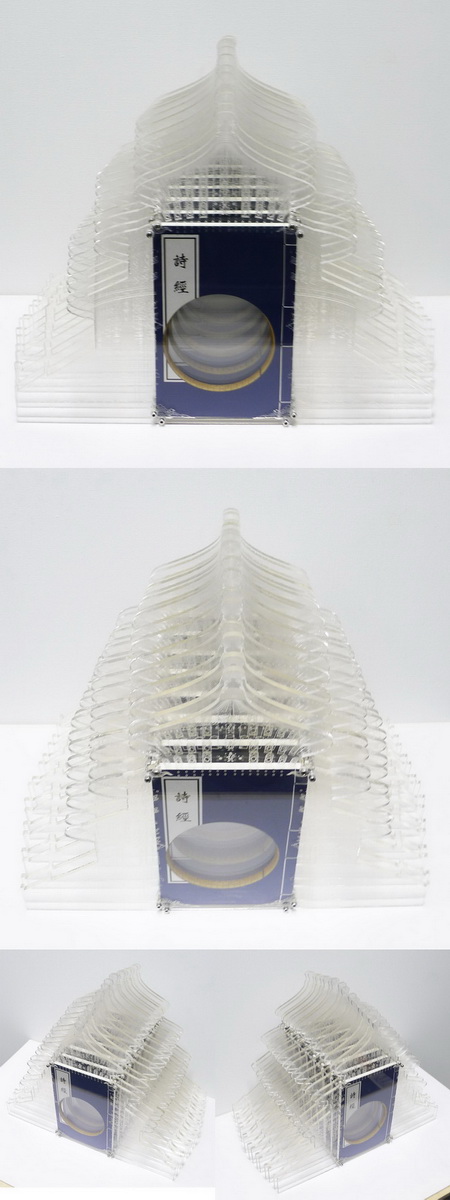
▲ 邓碧文《信仰的黑洞》装置;2012

▲ 徐一晖《月球上读红宝书》陶瓷雕塑
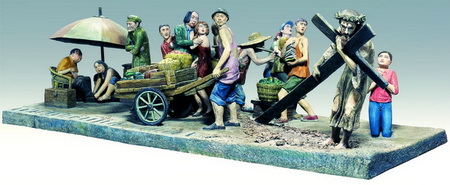
▲ 李占洋《黄桷坪基督》玻璃钢;250×80×70cm;2006

▲计文于+朱卫兵《思想的诞生和延续》旧木花架、细钢筋、铜丝、布、填充棉;161x37x34cm;2011
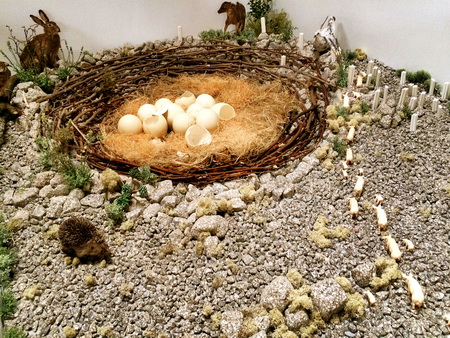
▲ 李琳琳《野人花园》局部;3mx2.1mx2.6m;综合材料;2016

▲ 陈庆庆《找达利吧!》混合材料装置;45x30x12cm;2014
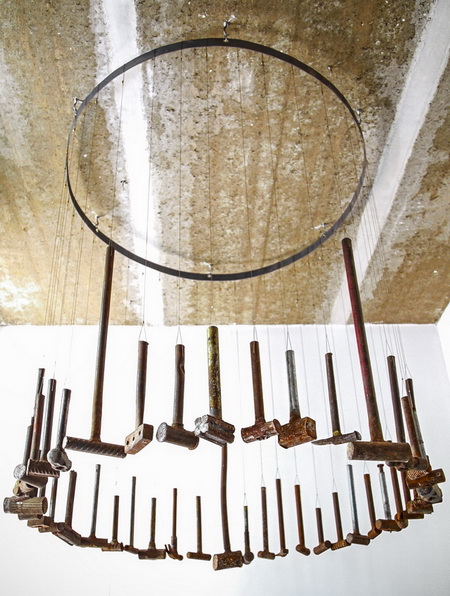
▲ 艾恩Arnd Christian Müller《圆环锤》
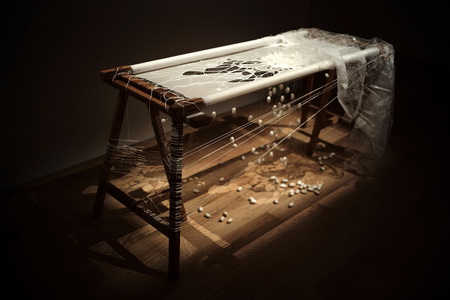
▲ 梁绍基《越》装置
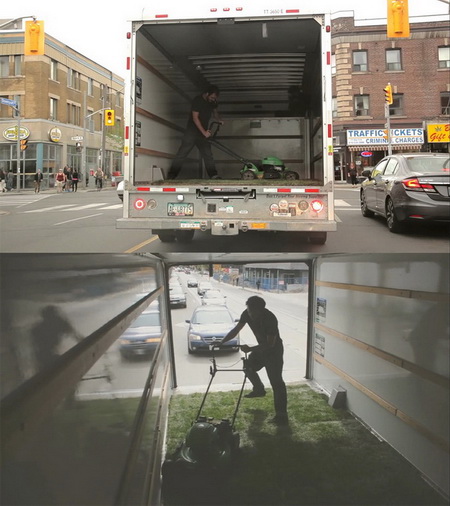
▲ Ash Moniz《Lagrangian Lawn》Video Performance;5min17sec;2015

▲ 秦树义《冷兵器》换气系列作品;装置;210x100cm;2013
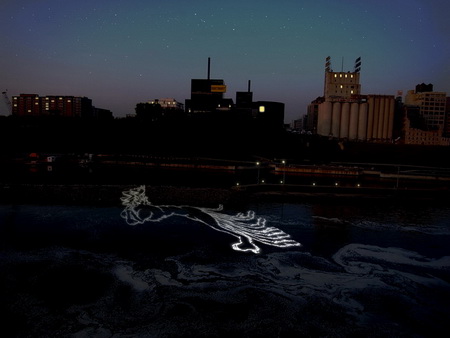
▲ 刘旭光《新山海经》360°旋转影像装置;3min31sec;2011
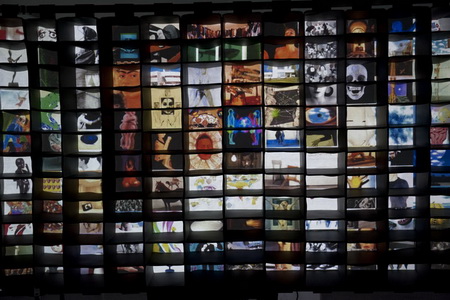
▲ 胡介鸣《一分钟的一百年》局部;影像与声音装置;2010

▲ 田晓磊《诗歌 》数字视频截图;2014
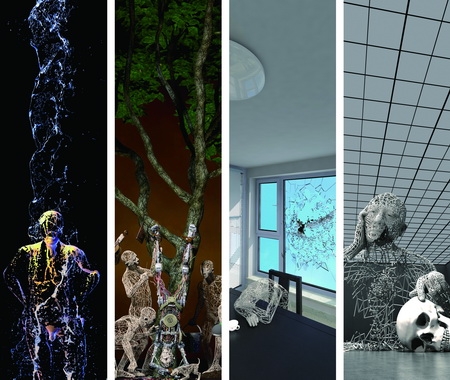
▲ 缪晓春《无始无终》动画截屏
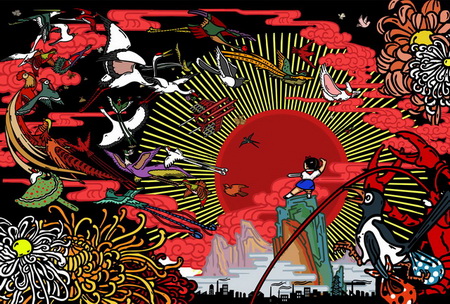
▲ 卜桦《公元3012》数码动画
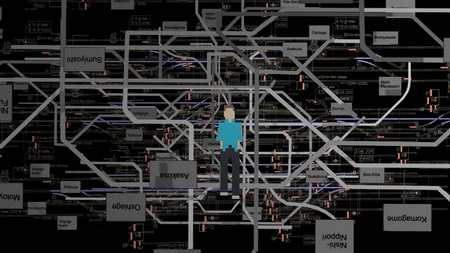
▲ 张小涛《三千世界》三屏动画;6分30秒;2014

▲ 邱黯雄《蛋糕》高清单频动画16:9;1920x1080;2014

▲ 钟甦《地久天长》单通道视频;17分钟;2015
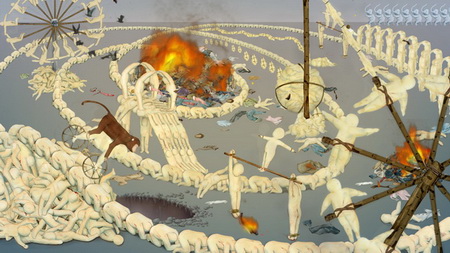
▲ 吴超&夏维伦《追逐·最后的狂欢》实验动画;单频;22分27秒;2011

▲ 卢杉《基因糖》视频截图;高清录像;17’18”;2015-2016
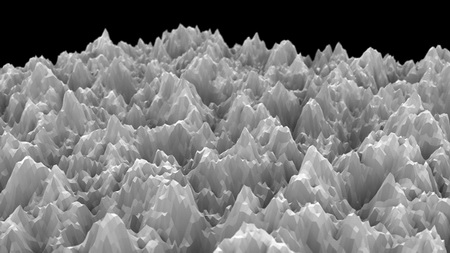
▲ 贾鹏森《数字山水》超清16:9;数字影像;3分;2015
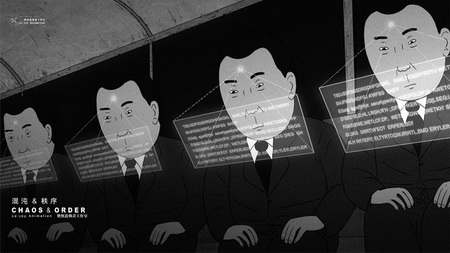
▲ 刘健《混沌&秩序》视频截图;时长2.47min;2011
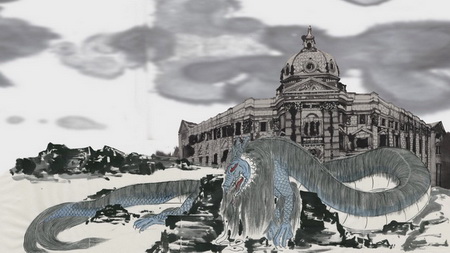
▲ 孙逊《主义之外》视频截图;8分08秒;2010
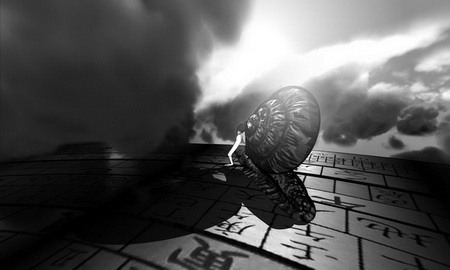
▲ 刘茜懿《天籁籁》视频截图;10min22sec;2012

▲ 何盛源《翛》视频截图;2K多路视频 装置;17min39sec;2016
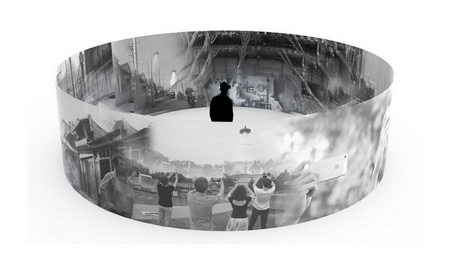
▲ 费俊+李心路《城市博物馆-记忆时空扭转》VR互动装置;2016
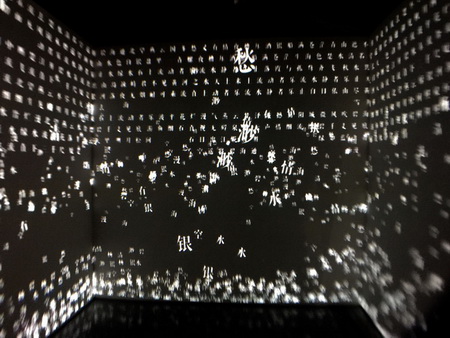
▲ 高文谦《物像之动-水之动》3’33;沉浸式影像;2016
全球语境下的中国式艺术
——【艺术郑州】2016 “全球中国” 当代艺术展手记
文︱张海涛(艺术评论家,策展人,艺术档案网主编)
全球互联的时代,世界政治、经济、文化互相影响,会加剧一元化话语权力的竞争,经济决定权利的一体化语境下文化的差异性和多元性显得尤为重要,起到平衡经济价值判断一切的作用。“中国式”的当代艺术是全球语境下区别于现在西方的艺术,它具有本土的气质。中国目前的当代艺术中有两点区别于西方的优势:一个是当下中国独特的生存环境和文化背景,还有一个就是中国传统经典的文化资源。这两点与西方具有差异性,是可以与西方站在同一个起跑线上对话的。中国当代艺术需要找寻体现中国不同于西方的现实生存感受、历史文化和思想的针对性,找到不同于西方的价值和生态体系,才是最重要的。
郑州地处中国南北通汇的地理位置,“烩”文化文明,几朝古都曾定都于中原,有很好的传统文化根基。但是近代以来反而这样的地方新文化滞后,相对保守,当代艺术很难渗透,这也取决于这里留不住人才,新的观念缺失,艺术教育的信息也相对封闭,做当代艺术展更加不易。艺术区建设、策展、评论、收藏等艺术生态在郑州都形成不了良性的循环,但是这里需要有人做别人不愿做的事,需要启动“传帮带”活动才能改变其现状。我们可以利用这个“杠杆”在这里去试一试水,势必有它的存在意义。绿地集团在中原大地推动“中国式”当代文化艺术的意义非常大,通过这个展览可以带动郑州乃至中原的文化格局,起燎原之势。也可让绿地综合品牌及实力提升,潜在此拉动地方文化产业的经济力量。
中国经典的历史文化形成的思维方式是否适合当代艺术的发展?毫无疑问是肯定的。当代艺术最重要的特征是“整合”,而“整体”观察和把握事物是东方式思维的重要特质。在当代艺术发展的历程中,曾有过几次重要的启示,西方艺术家在中国传统思想中发现了新的思想,受这些东方传统观念的影响而产生了具有东方特色的艺术形式。中国当代艺术也与东方思想结合将给传统思想观念带来活力,并与国际接轨的同时寻求中国艺术话语权。
东西方“中国式”当代艺术的历史脉络
20世纪初杜尚(Marcel Duchamp)作品中就透露出东方哲学思想,20世纪50年代,作曲家约翰·凯奇(John Cage)从东方“禅宗”思想中获取灵感,禅宗使西方人多少领会了理性的局限性。他们在敞开心灵,倾听大自然的声音中发现了新的美。日本物派作品中发散着东方自然朴素,非修饰的潜默力量。
出身于韩国活跃在世界舞台上的影像艺术家白南准,在20世纪六七十年代开拓了“电视”媒介以及卫星电视技术动态影像艺术这一新的艺术表现领域。以西方技术语言与东方思想融合是中国艺术发展趋向。
中国艺术家90年代在国际上出场,也是借用“中国牌”寻求与西方艺术的差异性。90年代“中国牌”这些作品很多是处于早期后现代主义解构时期的特点,包括概念化、符号化,还有一种打破和消解的感觉,比如火药、文字解构游戏、符号的空间和语境置换,打“中国牌”的艺术家一直在寻找中国和西方的价值冲突、文化冲突和差异性。但是如今很多把“中国式”资源进行转换的艺术家,更多是结合当下的认知和感受,作品更多也落到实处建构一些价值了。
敏锐和真诚的新感觉、新语言的经验就成为艺术价值判断最主要部分。作品话题的选择中对于历史、现在、未来和永恒思想的当代化转换都是使艺术鲜活不灭的重要本源。根据展览话题与符号关系我们将展览分为以下三个章节六个板块:【记忆】记忆图式、经典转换;【现实】社会实证、日常异常;【未来】科技未来、影像意象。比如一个永恒的经典思想,进行当代化的语言转换或者用经典的语言来表现新的感受都会有新的价值。
中国当下现实与展览意义
“中国式”从时间脉络关注的话题可分为“记忆、现实、未来”篇章,记忆篇关注经典的传统文化思想与历史资源的当代转换;现实篇关注当代艺术家对现实生存感受和观念的表达;未来篇是对将来的预设与想象。中国式的独特现实可以从几方面诠释,政治、经济、社会、文化,每个领域都有中国特色的文化针对性,中国有世界上独有的体制,必然有不同于西方的经济特点,社会现象和事件也具有中国式的荒诞特性。文化上由于惯性思维模式一路追赶西方脚步,五四以来的西方现代文化与传统文化搅在一起,形成了中国现有的国别特征。经济的高速发展,百姓为生活所迫,人人都沦为“商人”。经济指数第一、娱乐消费至上,必然导致社会性的“暴发户”文化、道德伦理缺失、人情淡泊、名利炒作,所有的新闻性、社会骗术都是其他国家所没有的。礼尚往来成了“关系”人制的社会,法制观念弱化,以“丑”为荣的网红,是平民观念造反精英文化所致——所谓的“网红成名”都有商家买单。中国式变态的社会现象层出不穷,每个人在这个社会关系的漩涡中都逃不了干系。
全球化以经济至上的理念发展时所有的文明就以此成为标准了,经济掌握了一切话语权:文化都围绕着经济的变化而变化着,都转换成了产业文化,都要转换成金钱,不然没法生存,中国人的价值标准和世界观都在变化,这些现象在世界上是独有的,也自然都成了“中国式现象”。连大众影视都会以“中国式”为名,如“中国式离婚”、“中国式关系”等。“中国式”是个中性包容的词,可以是正能量的,也会是负能量的,所有中国独特的文化与社会资源都可以为艺术家所用,提倡和传承积极的中国式文化,摒弃或抵制消极的中国式现象是艺术家提出的深刻问题,也是我们的展览意义所在。
2016年9月于北京

▲ 花俊《不生不灭》影像截图;3分钟;2015
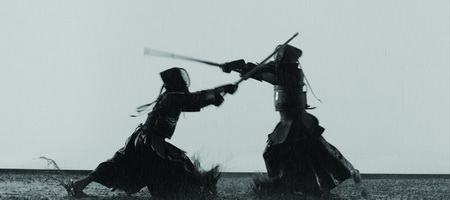
▲ 杨泳梁《陌入止境》数字影片;58分13秒;2015

▲ Garcia Frankowski《Poem of the Triangle》Diptych;Two Chanel Video Installation;Sound;2015
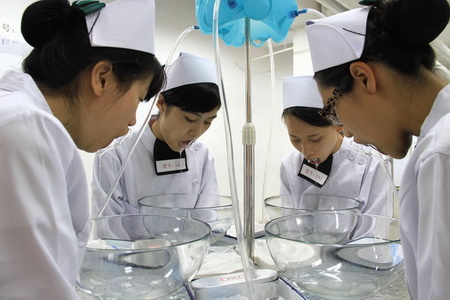
▲ 陈友桐《生产》综合、现场;2013

▲ 周罡《中国》实验短片;双屏;彩色;高清;34分20秒;2015

▲ 马腾飞 Martin Derbyshire《Codeswitcher 代码更改》视频截图
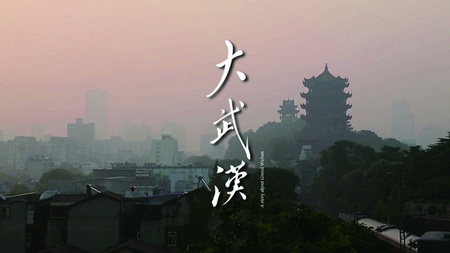
▲ 张彦峰+周罡《大武汉》纪录片;高清、彩色;09分48秒;2014

▲ 张琪凯《丙申-3》架上综合材料;124×124cm;2016
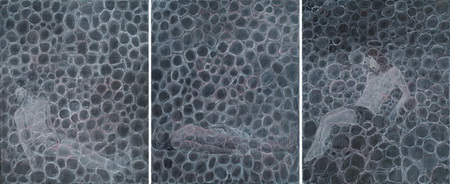
▲ 祁志龙《基督之殇》画布丙烯;260x210cmx3;2015
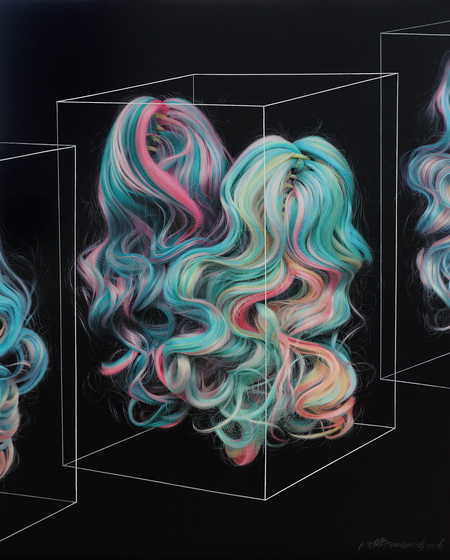
▲ 江衡《静物之四》150X120cm;布上油画;2016
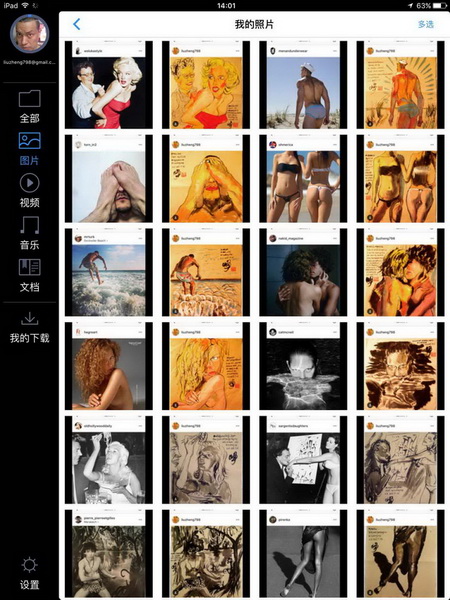
▲ 刘峥《Instagram网络涂鸦互动项》43×41cm;2015

▲ 常徐功《刺绣·绣像系列》布上刺绣;200x160cm;2013

▲ 李山《社会敏感性研究与发展计划项目》

▲ 张浩《心灵被照亮的时刻》宣纸水墨;168x124cm;2014年
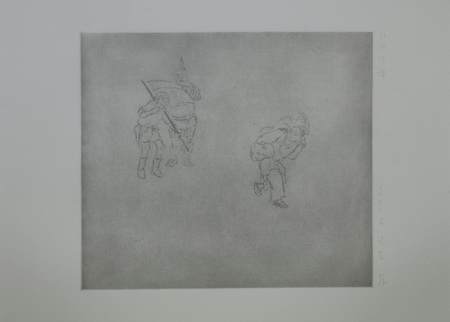
▲ 武艺《行拥供母》铜版画;35cm×40cm;2016

▲ 姬子《元初》纸本水墨;661×190cm;2011
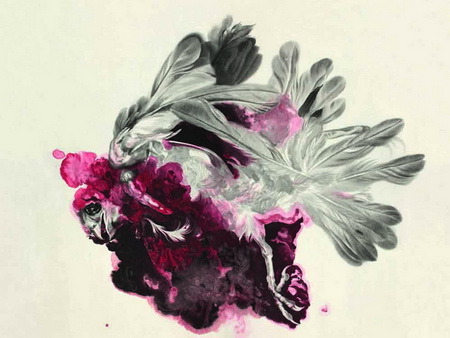
▲ 伊瑞STRAKA JIRI《被碾压的麻雀》宣纸水墨;360×280cm;2011

▲ 张正民《围·观之一》综合纸本水墨;96cm×230cm×4;2013
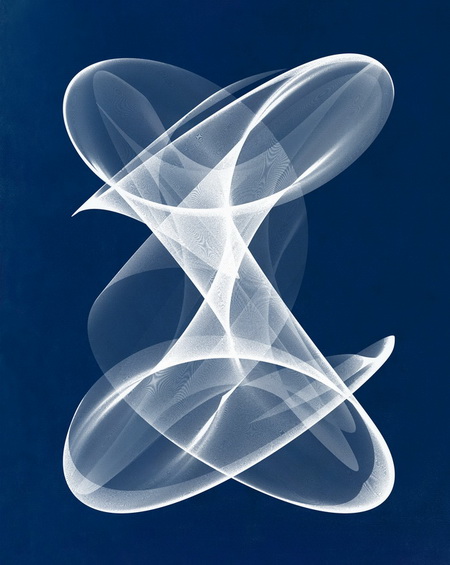
▲ 马晟哲《Qi-2016 No.25》纸上蓝晒;96x76.5cm;2016
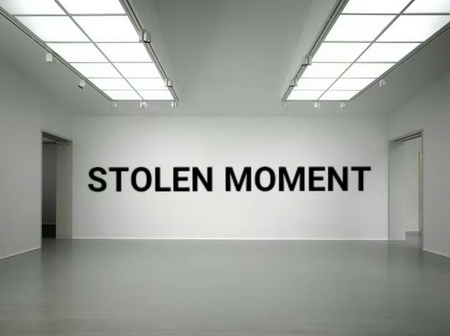
▲ 路赛·贝通Russell Beighton《无题:被偷走的时间》乙烯基贴纸;2016

▲ 戴翔《新清明上河图》局部;摄影/图片;115×2500cm;2014
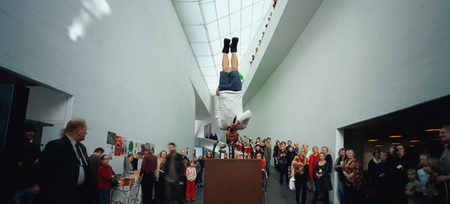
▲ 李暐《自由的讲台》照片;176×388cm;2008

▲ 金江波《Patea冷冻工业:Tanaraki现场》摄影;300×115cm;2009

▲ 谭海山《1立方土和里面的628样物品》行为图片;2008
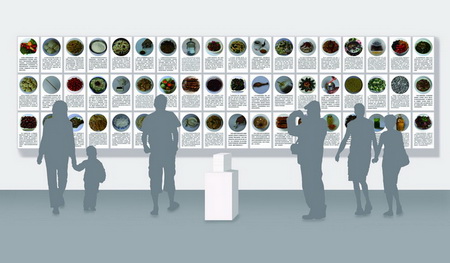
▲ 梁越《毒54》图片54幅,每幅50.8x84cm;2012

▲ 张巍《人工剧团-英雄雷锋》艺术微喷;100x130cm;2014
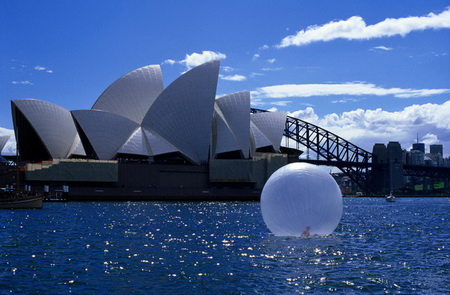
▲ 朱冥《2003年3月9日A号》图片;创作地点:澳大利亚悉尼;126×83cm;2003
艺术、科技与商业空间
文︱王泊乔(艺术策展人,中国国家博物馆顾问,中国数字艺术协会秘书长)
近年的当代艺术展览史中,艺术介入公共空间,尤其是商业公共空间的案例频繁出现,如著名的K11莫奈展,作为策展人,蒋非默和我早在K11之前就在上海时代广场、环球金融中心等全国数个地标性商业空间和建筑物中策划艺术展,但传统的艺术形式已经不能适应巨大而且环境复杂的公共空间,所以我们在展览中加入了很多艺术科技的作品,互动装置、多媒体影像,让展览有非常出人意料的效果。这样的展览实验检验了中国当代艺术本土化的成果,实践证明这个成果是丰硕的;还体现了当代艺术蓬勃发展带来的溢出效应,其中尤为明显的是社会效益。
借助商业公共空间,尤其是这次“全球中国”当代艺术展的举办地点郑东绿地中心这种城市地标式建筑,本身它就天然具有的巨大人流量,让更多的社会大众,尤其是社会精英阶层,近距离体验、感受当代艺术,这无疑是一种绝佳的艺术普及方式。这种普及,有利于提升城市人群的艺术修养,开阔视野,丰富文化体验。商业空间巨大的辐射效应,会对艺术展影响力的扩散提供强大助力,让它走进城市的每一个角落。
同时,高水准艺术展,也能为商业空间营造浓郁的文化氛围,留下文化印记,使空间本身在建筑属性和商业属性之外,具有丰富的文化属性。具有了文化属性的商业空间,就大大提升了在城市文化构建中的话语权,不仅仅是建筑地标,甚至有可能成为一座城市的文化地标。
中国当代艺术发展到今天,越来越需要社会各界的支持和参与,越来越需要深刻融入当代中国社会,只有深刻根植于本土,才能迸发出更大的艺术创造力。更多、更好的艺术作品,不但是艺术家的责任,也是社会的需求,期待本次展览能在中原大地培育出当代艺术生长的土壤;期待通过艺术对公共商业空间的植入,让当代艺术在商都的城市文化中留下一抹亮丽的色彩;期待更多的郑州人认知、喜爱当代艺术。
我深刻地体会到,全球化语境下后现代城市主义对商都城市文化的深层次浸润和再塑。如果在郑州住上一周,就不难发现,上述的这种变化,广义上体现在城市各要素的相互作用间;狭义体现在城市精神意识形态的发展上。
这次展览,让我们看到了当代艺术在中原大地蓬勃发展的可能性,也让我们有机会了解,到底什么样的当代艺术才是属于中国民众的当代艺术——它不应是曲高和寡的艺术实验,也不应是珍罕且脆弱到令人不敢触碰,更不应是媚俗和低级的趣味,它是全球文化视角下,新时期中国艺术家立足本土、体验现实后,表达自身认知的艺术实践。这些实践体现了当代中国人的生存感受和文化理念,颇接地气。
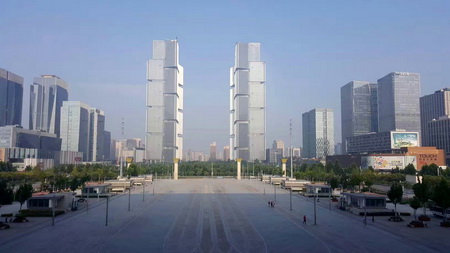
▲ 郑东绿地中心外景

▲ 郑东绿地中心外景
Art Zhengzhou
2016 “Global China” Contemporary Art Exhibition
Producer: Fang Dongxing
Art Adviser: Wang Mingxian
Academy Director: Wang Chunchen
Curators: Jiang FeiMo, Wang Boqiao, Zhang Haitao
Curator Assistants: Zhao Lei, Cao Ying, Wang Jian, Su Yong
Sponsored by: Green Land Group • Zhong Yuan
Organized by: Shanghai Nature Awe Art Center
Opening Time: 16:00, Oct.29th (Saturday), 2016
Exhibition Duration: Oct. 29th, 2016 – Dec. 31st, 2016
Exhibition Location: Green Land Group Center of Zheng Dong
Artist (in alphabetical order by last name):
Ash Moniz (Canada), Arnd Christian Müller (Germany), Bian Xiaomeng, Bu Hua, Garcia Frankowski(Puerto Rico/ France), Cang Xin, Chang Xugong, Chen Qingqing, Chen Wenling, Chen Youtong, Dai Xiang, Deng Biwen, Fei Jun+ Li Xinlu, Gao Wenqian, Guo Gong, Johannes Nielsen (Sweden), Han Xing, He Shengyuan, Hu Jieming, Hua Jun, Ji Zi, Ji Wenyu+Zhu Weibing, Jia Pengsen, Jiang Heng, Jin Jiangbo, Li Hongbo, Li Linlin, Alessandro Rolandi (Italy), Li Wei, Li Zhanyang, Lee Tzu-hsun, Liang Shaoji, Liang Yue, Lin Xin, Liu Jian, Liu Qianyi, Liu Xuguang, Liu Zheng, Lu Shan, Russell Beighton (UK), Martin Derbyshire (UK), Ma Shengzhe, Miao Xiaochun, Qi Zhilong, Qin Shuyi, Qiu Anxiong, Qiu Yu, Shao Yinong, Shi Jinsong, Sun Xun, Tan Haishan, Tian Xiaolei, Tong Kunniao, Wang Lei, Wang Wei, Wang Weisi, Wu Chao + Xia Weilun, Wu Gaozhong, Wu Mengshi, Wu Yi, Xu Yihui, Xu Zhongmin (UK), Yang Yongliang, STRAKA JIRI (The Czech Republic), Zhang Hao, Zhang Lidan, Zhang Muchen, Zhang Qikai, Zhang Wei, Zhang Xiangxi, Zhang Xiaotao + Yu Yuexiong, Zhang Yanfeng, Zhang Zhengmin, Zheng Da, Zhong Su, Zhou Gang, Zhu Ming
Observing China with “Global China”
---- Contemporary Art Exhibition in Zheng Zhou
Wang ChunChen
When we talk about China today, it’s not limited to China only, but also about the world, and also about the global. China was formed after the long term fusion and interaction of multi-ethnic and multi-culture in the history. Therefore when we come to the age of globalization flown with the world trend, we have to face the new challenges and new structures, which will also give us the brand new vision of “Global China”.
Standing on the platform of the 21st century, “Global China” explores our directions forward with historical dimensions. It’s also quite meaningful for this exhibition to be held in Zheng Zhou, for Zheng Zhou is located in the middle of China with a long-standing history and a grand area. It used to be the core district during the most prosperous age of Han Dynasty and Tang Dynasty, and has created one of the most glorious civilizations in the history. The Buddhism was firstly located in this area when it came to the east during East Han Dynasty, indicating that this area used to be the center to guide the world at that time. “China” used to mean for “the country inside a country”, which was referring to this middle area of China around Zheng Zhou. The art in Song Dynasty is one of the peaks in Chinese Art. It is admired for its grandness and magnificence. The middle of China back then was the place to embrace the whole world, where people exchanged various thoughts with different languages (Religions like Buddhism and Nestorianism were all firstly spread out from this area). The characters and dispositions of people, during Han, Tang and Song Dynasty, were heroic and generous, great with absorbing essences from the whole world. The folk poetry collection famous with its orderly inheritance have nourished the world and enlightened our hearts for thousands of years. When we retrospect the Sage in the history, we can’t help pondering over with deep sighs, for “the middle of China” back then was somewhat like the concept of “the global” of today, which overlook the world with a broad vision, a rich knowledge base, and a tolerant heart. Therefore, “China” is not just limited to the middle area of China. It holds the open mind with “the world” instead. The ancient book “Shan Hai Jing” may sound like a myth, but it is actually the guide book for our ancestors to understand the world, and a valuable bible to appreciate the treasure in the world.
Therefore, it is a good will to bring up the “Global China” in our age of new contexts, which connects with our historical verve and aims for the whole world by absorbing the essence from different cultures and accepting various culture achievements. This “Global China” is not just the cultural concept of only “China”. What it’s pursuing and broadcasting is the outstanding civilization and culture all over the world. The vigour and creation are generated from the worldly concept, which is the shared character and value under the globalization. We’ve endowed the new meaning of “Global China”, that is to add the world factors into the concept of “China” and not to restrict it locally. “Global China” is also the brand new culture creation, just like the emerging and prospering of renaissance in Italy, which is not limited in Italy only. Instead it was acquired with the injection of new knowledge after absorbing and connecting the essences from the whole ancient civilization in Europe and Asia. As to art, “Global China” has helped us with a wider vision with extra power, which is exactly what we need while developing our Contemporary Art today.
If we observe the development of art in recent 30 years in China, we could see this path clearly. Were our artists not opening their hearts and expanding their vision, they would never take various new methods to express art, nor would they present the world by digging into the perception of globalization commonness. Even though they borrowed the existing classic language to present art, they’ve strived very hard to convert the expressive force of the age to add the contemporary new perception into it. When we glance over the art works of this exhibition, we will find that the mindedness of China Contemporary Art could be observed by “Global China”. We used to define and divide Chinese Art in several aspects, like it has to be ink paint and ceramic when comes to media, and the themes have to be flowers, birds, grass and insects, or mountains, rocks, trees and woods. In recent years, it has to be realistic, concrete, narrative, characteristic and etc. when talking about Chinese Art. These numerous theories would restrict the understanding of people from time to time. It seems like nothing else should show up in Chinese Art, and if it does happen, it has to be exotic, which is not reasonable, nor is it regarded as Chinese Art. This conclusion is agreed by the majority. Hence, in order to develop Chinese new art and new culture on a broader base, the purpose to bring up “Global China” is to open our minds, so that Chinese artists, during their art creation, won’t be constrained by those restricted subconscious concepts. Instead, they should devote themselves in every possible way to present art with a decisively mind.
With this big wish and great mind, we could come to enjoy the art of this exhibition again. We could acquire the freedom and happiness either as an audience or as a researcher. The freedom comes from the touch and poignant resulting from the word of Art while facing the abundance and variety of art, which contains not only diverse types and different media but also rich meaning and varied scenes. The artists, who are active in current Chinese Art, have lived up to their pursuing dreams of art creation --- their art imagination co-exists with their acquired art freedom at the same time, and the possible art challenges they may encounter also lies in how they try every possible media and methods. If this is not art, what is it? As a concept, the “Global China” has affirmed their validity and possibility to pursue international languages and methods. In the meanwhile, exhibitions like this are also a way for us to retrospect the marks Chinese Art left in the contemporary. They have vividly presented how the art concept of “Global China” was structured, which is not limited into one object, nor does it belong to a certain group. It is full of diversities instead. The meaning of diversity is not as simple as either a little more or less. It has reflected and influenced the distance and emotions between human and the world. “One” is the sole bias, which could lead to the narrow-minded and the stubbornness, then to the decline of art, because the nutrition is so limited that it has a negative impact to absorb new creations. “One” tends to simplify the richness and variety of the world, which is the big taboo for Contemporary Art. It is the annotation of “Global China” that will test our intelligence, explore our talents, and improve our imaginations.
The Global is synonymous with abundance. China is exactly the long-lasting existence in the history. The meaning of “Global China” occurs when the global and China connects with each other. The “Global China” is not only China’s China, but also the China of the whole world, the China with peace, the China in pursuit of improvements, and the China to share knowledge and values with the whole world. China, at this moment, is the pursuit and accomplishment of China in recent one hundred years. As the public worldly language, art, with its unique charm, has helped people around the world to share the civilization, emotions and wisdom. No matter what type of Contemporary Art it is, it will all enlighten audiences like us to realize: We will be no longer lonely. There are ample creations waiting for us on our path of exploration, which will sooth our hearts and souls.
This is to say: That is exactly where the art of “Global China” lies.
HuaJiaDiBeiLi, Beijing
Midnight of Sept. 28th, 2016
Chinese Art under Global Context
----- (Art Zheng Zhou)2016 “Global China” Contemporary Art Notes
Zhang HaiTao
In the age of Global interaction, the influences between global politics, economy and culture will intensify the competition of centralized discourses. It has become especially vital of the culture differences and diversities under the centralized context of which economy decides the right, and it has also balanced the effects that economic value decides all. “Chinese Style” contemporary art differs from current western art under the global context, and carries its local characters. I believe there are two advantages of Chinese contemporary art comparing with western art: One is the current unique environment and culture background of China. The other is the Chinese traditional and classic culture resources. These two points, I believe, are different from the western, and are able to talk to the west on the same level. It is crucial for Chinese contemporary art to search for the practical survival feelings, to focus on history, culture and thoughts, hence to find the ecosystem which is different from western values.
Zheng Zhou is located between the south and the north of China, with a typical culture of “mixing”. Several capitals in historical dynasties were located in this area, which has built up a great base of traditional culture. But since modern times, the new culture here is lagged and conservative. So it’s pretty hard for Contemporary Art to seep in. Also due to the missing of the talents, the absence of new ideas, and the lacking of art education, it has become very hard to develop Contemporary Art. We can’t set up a virtuous cycle for art ecology here in Zheng Zhou, such as setting up art zones, arranging exhibitions and art reviews, and collecting artworks. However, I believe we need people here to do things which have not been done by others, and initiate activities like “teach-help chain”, thus to change the current situations. We could use this “lever” and give it a try here, and the meaning will for sure emerge. It is extremely meaningful for the Greenland Group to promote “Chinese Style” contemporary art in this central China area. We could improve the art pattern in Zheng Zhou and even in Central China through this exhibition, then igniting the whole area. In the meanwhile, the brand of Greenland could also be promoted, which would empower the local economy through the culture industry.
Is the thinking method formed under Chinese classic historical culture compatible with the development of Contemporary Art? The answer is absolute without a question. The most important character of Contemporary Art is “integration&rdquo

